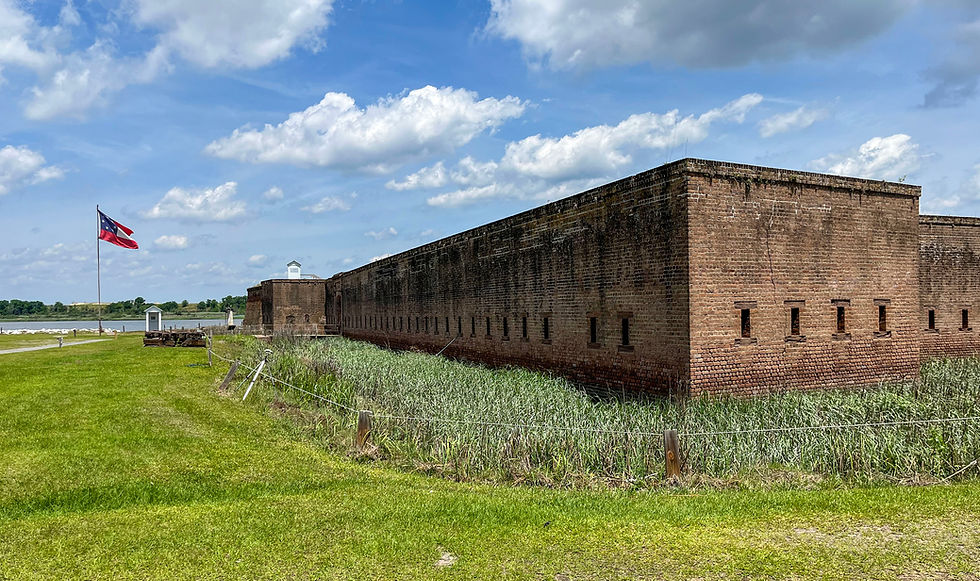Brushy Mountain State Penitentiary
- Tim Murphy

- Jul 9, 2023
- 9 min read
The socioeconomic programs of Reconstruction stimulated extensive infrastructural development within the former Confederate states. Sprawling new-construction railroad networks connected Tennessee’s once-remote coal mining regions to major industrial centers, rousing the demand for cheap labor. Like many of its destitute southern counterparts, Tennessee adopted the parsimonious convict leasing system—the exploitation of state-sanctioned punitive labor by private entities. Unfortunately, this controversial economic practice bore a striking resemblance to chattel slavery, as many of these convicts were black.
The region’s penal landscape became disproportionately hostile towards African Americans post-Reconstruction. Southern lawmakers, who harbored prejudicial resentment towards former slaves, instituted Black Codes—oppressive legislative actions meant to disenfranchise the African American community. Black individuals suddenly found themselves facing severe penalties for petty crimes such as vagrancy, loitering, and unemployment. Racist social sentiments and broad legal interpretations allowed for easy convictions in court. Soon enough, black offenders constituted the majority of the southern prison population.

Mining companies were the primary beneficiaries from Tennessee’s convict leasing system. Environmental dangers and innate occupational hazards necessitated a readily available workforce. Convict miners suffered high mortality rates in these conditions, but the state had little financial incentive to ensure their safety. Convicts, like property, were deemed expendable—easily replaced by a seemingly inexhaustible human supply.
THE COAL CREEK WAR
Although convict leasing was a lucrative system for private businesses and state entities, it effectively suppressed competitive wages for civilian miners, many of whom were indebted to mining companies for housing and basic necessities. With their livelihoods at stake, free miners organized unions to protect their interests. In 1890, several members of the labor-friendly Tennessee Farmers’ Alliance were elected to the state government, including Governor John P. Buchanan. These appointments emboldened unionized miners to voice their concerns to the Tennessee Legislature. Labor representatives petitioned for the abolition of scrip currency (which could only be redeemed at company stores for pennies on the dollar) and mutual appointment of checkweighmen—specialists who measured coal loads and determined how much a particular miner earned. Both of these demands were codified into law and most mine companies accepted the terms; however, the Tennessee Coal Mining Company defiantly rejected. They shut down their Briceville operation on April 1, 1891, and reopened two months later with an unpaid convict workforce, effectively terminating civilian employment. To add insult to injury, Tennessee Coal demolished its former employee housing and built a stockade overtop.
On July 14, three hundred armed miners—outraged by this audacious disparagement—encircled the stockade, apprehended its occupants, and shipped them to Knoxville along the Coal Creek Railroad. Two days after the hostile takeover, Governor Buchanan personally returned the convicts to Briceville and left them under the guardianship of Colonel Granville Sevier and 107 state militiamen. On July 20, an estimated two thousand miners—many of whom were pro-labor activists from East Tennessee and Kentucky—surrounded the stockade again, forcing Sevier’s surrender and subsequent embarkation to Knoxville. State officials managed to acquiesce a sixty-day armistice with the miners, contingent upon the governor’s public recommendation to repeal the convict leasing system.
On August 31, 1891, a special session of the state legislature convened (at Governor Buchanan’s behest) over the legality of convict leasing. After three weeks of debate, Tennessee lawmakers—corrupted by laissez-faire capitalism and corporatist influence—upheld the exploitative labor practice and criminalized acts of interference affecting the system. This fateful decision ignited the Coal Creek War.

On October 31, vigilante coalminers burned the Tennessee Coal Mining and Knoxville Iron company stockades in Coal Creek, releasing over three hundred convicts in the process. A similar uprising occurred on November 2 at the Cumberland Mine in Oliver Springs, where 153 prisoners were freed. In January 1892, Governor Buchanan mobilized 84 Tennessee National Guardsmen under Colonel J. Keller Anderson to protect the remaining convict workforce in Coal Creek. Upon their arrival, state soldiers constructed Fort Anderson—a commanding, defensive stronghold whose Gatling Gun and Howitzer cannon were menacingly trained on the insurgent “Miners’ Nest” encampment and civilian structures inside the embattled company town. Harassing small arms fire increasingly disrupted the Tennessee countryside as tensions mounted between the miners and state militia.
Months of hostility and intimidation boiled over in August 1892, when militant miners launched coordinated attacks against company stockades throughout the Coal Creek Watershed, resulting in the release of nearly seven hundred prisoners. Colonel Anderson was captured during this renewed offensive, leaving Lieutenant Perry Fyffe to command the state garrison. Armed miners surrounded Fort Anderson and demanded its surrender, but Fyffe refused. A shootout erupted between the belligerents, killing two militiamen, but the miners were ultimately repulsed.
Violent unrest yielded to martial law following the arrival of General Samuel T. Carnes and his 583 Chickasaw Guardsmen. Carnes swept the Coal Creek region, detaining hundreds of alleged insurrectionists and complicit conspirators. These unrelenting mass arrests, combined with dwindling public support, forced the miners to surrender in October 1892.
Fifteen months of anarchy resulted in dozens of casualties, yet little change concerning Tennessee’s labor laws; however, the state legislature—absorbed by national media attention and mounting militia costs—voted to resolve the conflict in the miners’ favor. In 1893, lawmakers passed the Penitentiary Act, which promised to abolish convict leasing by 1896 and develop a "progressive" system of prison labor: Brushy Mountain State Penitentiary and Coal Mine.
BRUSHY MOUNTAIN: THE END OF THE LINE
“The inmates have been through everything the system can give them. Telling anybody we were in
rehabilitative services is the biggest lie. Our main concern was perimeter security.”
– Stonney Lane, Brushy Mountain Warden (1976 – 1995)
Brushy Mountain opened its doors on January 1, 1896. The original wooden structure housed five wards and complemented 120 inmates; however, within a decade of operation, the prison’s population exceeded four times its intended capacity. Approximately two-thirds of Brushy’s prisoners labored in adjacent, state-owned coal mines, expected to load several tons of coal per day. Prison officials maintained a strict productivity system incentivized by rewards and positive punishment. Convicts who exceeded daily quotas could receive supplemental income (ranging from 5-40 cents per ton) or expedite their eligibility for parole. Conversely, underproductive inmates were routinely beaten, provided low-quality food, or even placed in solitary confinement. Between 1903 and 1917, the state realized $1.7 million in net profit from the Brushy Mountain Mine.
By 1927, Brushy Mountain’s population had risen to 919 inmates, the overwhelming majority being African American. Chronic overcrowding—along with poor sanitation and dangerous work environments—led to high rates of death, illness, and violence. These abhorrent living conditions compelled state officials to construct Brushy’s extant structure, which was completed in 1935.
Mining remained the prison’s primary enterprise until 1967 when two inmates were killed in a rock fall. This accident sparked widespread public criticism promulgating the inhumanity of convict labor and ultimately forced the state to permanently close its mines. Prison officials attempted to replace forced work programs with reformative services, hoping to reduce violence and facilitate better transitions from captivity to freedom; however, in 1969, Brushy Mountain was reclassified as Tennessee’s first maximum-security prison, effectively ending such remedial efforts.

Brushy Mountain incarcerated some of Tennessee’s most heinous offenders, but the prison’s most infamous inmate was James Earl Ray—the convicted killer of Dr. Martin Luther King Jr. Ray was a career criminal prior to Dr. King’s assassination. After being dishonorably discharged from the U.S. Army for “ineptness and lack of adaptability,” Ray spent several stints in prison for fraud and robbery. In 1959, while on parole for an earlier theft, Ray was convicted of robbing two St. Louis grocery stores. Given his extensive lawbreaking history, Ray was issued a twenty-year sentence and placed in the Missouri State Penitentiary in March 1960. In 1967, Ray managed to escape his penal facility by hiding inside a bakery truck. He remained on the run for over one year.
On April 4, 1968, under the pseudonym Eric S. Galt, Ray rented a room at Bessie Brewer’s Rooming House in Memphis. Tennessee, directly across the street from Dr. King’s accommodation at the Lorraine Motel. At 6:01 pm, Ray shoots the civil rights leader from his boardinghouse window and immediately flees, launching the FBI’s most expensive manhunt in its history. After two months of searching, Ray—masquerading as a Canadian citizen named George Sneyd—was finally apprehended at London’s Heathrow Airport. The international fugitive was extradited to the United States where he initially pled guilty to murder, but later recanted and claimed to be the scapegoat of an elaborate government conspiracy. James Earl Ray was ultimately sentenced to 99 years at Brushy Mountain State Penitentiary.
Considering Ray’s track record of escape and evasion, it comes as no surprise that he made several attempts to break out of Brushy. In June 1977, Ray found temporary success after he and six other inmates scaled the prison’s northeast wall with a makeshift ladder assembled from scrap pipe. The jailbreak sent panic across Tennessee. Within hours, the FBI and U.S. Marshal Service had launched search parties from their command centers outside of Brushy Mountain. After 58 hours of flight, Ray was discovered by local investigators hiding underneath a pile of leaves just three miles from the prison. Ray remained at Brushy until 1992, when he was transferred to the Nashville State Correctional Facility due to ailing health. He died from complications of Hepatitis C on April 23, 1998.
In 1972, Brushy Mountain’s prison guards organized a strike protesting the facility’s unsafe working conditions and inadequate amenities. The penitentiary was subsequently shut down until 1976, when legislators allowed the guards to unionize. In 1980, Brushy Mountain was redesignated as a “classification facility” following the opening of Morgan County Regional Correctional Center—a 400-bed facility in nearby Wartburg, Tennessee—signifying the shift from central penitentiaries to regional prisons. All convicts in East Tennessee were processed through Brushy and given a security designation before being transported to their respective penal institutions.

The New York Times once described Brushy Mountain as a “racial powder keg” fueled by internal contraband trades and longstanding racist policies. This volatile environment ignited on February 8, 1982, when seven white inmates—armed with shanks and a .25-caliber pistol—took four guards hostage and confiscated their keys. The rioters stormed the segregated third-tier cells and fired on black inmates cowering behind mattresses. The white convicts surrendered to the prison medic after their 45-minute rampage left two dead and two others wounded. Investigators were never able to determine how the pistol was smuggled in, but some suspect complicity between the white guards and inmates; however, there is no proof to support that claim.
During the late 1990s, state officials implemented a comprehensive prison redevelopment program that expanded the Morgan County Correctional Complex and accelerated Brushy Mountain’s demise. On June 11, 2009, Brushy Mountain State Penitentiary closed after 113 years of operation. The historic penal complex reopened in 2018 as a regional tourist attraction containing a museum, restaurant, concert venue, and distillery.
General admission to Brushy Mountain includes a self-guided walking tour of the former penitentiary (ticketed entry is required at the Main Prison’s central processing corridor). The first recommended stop is the Prison Museum—housed in the former library—which features a twenty-minute documentary, jailhouse memorabilia, newspaper clippings, and inmate artwork. Adjacent to the museum is the Laundry and several subterranean cells collectively called “The Hole.” These dingy basement chambers (originally measuring 144 cubic feet) once held Brushy’s most disruptive and combative prisoners. The Hole received little ventilation and almost no sunlight. Depending on the length of confinement, some prisoners would temporarily lose their sight due to the darkness. Whippings were another common penalty for unruly convicts. Guards tied offenders to a whipping post—still visible in the Lower Yard—and inflicted their punishment with a four-foot leather strap. This corporal practice was not officially outlawed until 1965.
Back inside the Main Prison, visitors can explore Brushy’s cellblocks, caged walkways, and communal facilities. Located on the second floor, the Cafeteria is one of the penitentiary's most notorious locations—its busy environment and access to cutlery made it an ideal location for planned hits and opportune violence. In one gruesome instance, two convicted murderers attacked a defenseless inmate with a meat cleaver and butcher knife, severing the victim’s spine and disarticulating his arm in the process. Prison officials later installed armed guard observatories with bulletproof glass to mitigate the threat of inmate aggression.
On the west side of the Main Prison is D-Block—Brushy Mountain’s solitary confinement quarters. Prisoners here were stripped of all privileges and possessions and caged behind triple-locked doors. Despite these high security measures, D-Block gained infamy as a site of perpetual violence and bloodshed. In 1989, the 96-bed High Security Annex Building (also known as “The Tombs”) was constructed behind the Main Prison to prevent D-Block from overcrowding.

Brushy’s malevolent history acts as a harbinger for paranormal activity. Disembodied voices, unexplained shadows, and ghostly apparitions serve as intangible manifestations of tragedy and desolation. One of Brushy Mountain's most famous ghosts is a convict named Jack Jett, who developed an unfortunate reputation of being a snitch. One evening, while he was calling his mother from a prison phone, two inmates shivved Jett in the neck, causing him to bleed out. His spirit allegedly makes its presence known by levitating the phone receiver off the hook.
D-Block is considered one of the penitentiary’s most active sites. The solitary confinement cells were constructed over the former morgue, where countless bodies were stored before being sent home or buried in the prison cemetery (about a half-mile south of Brushy Mountain). Small headstones originally marked convict graves, but years of weathering and vandalism have permanently expunged their identities.
Though no longer a direct beneficiary of convict labor, Brushy Mountain State Penitentiary continues to incite controversy. Many criticize the Brushy Mountain Group for placing too much emphasis on the prison’s gruesome violence while simultaneously “sanitizing” the race and labor relations entrenched in its legacy. There is also a sentiment that Brushy Mountain heroizes Morgan County’s affiliation with incarceration rather than taking opportunities to examine the historic and contemporary implications of American prison systems (like Eastern State Penitentiary does). The complex history of Brushy Mountain certainly warrants deeper sociocultural analysis, but perhaps the most contentious complaint concerns the site’s excessive commercialism and merchandising efforts—exploiting the experiences of those impugned by America’s racialized carceral practices. Brushy Mountain is hardly a malicious marketing scheme, but one should understand the broader, contextual undertones this historic site represents before visiting.
Visit Brushy Mountain State Penitentiary for more information regarding tour options and local events
Check out Roadside America, Abandoned Online, The Washington Post, Weird Marketing Tales, and Nashville Scene for more Brushy Mountain history
For more information on the Coal Creek War, visit the Coal Creek Watershed Foundation and Jacobin
Interested in spooky stuff? Listen to Obscure Appalachia, Hometown Ghost Stories, Two Girls One Ghost, Oddity Poddity, and Tennessee Ghosts and Legends podcasts
Read the following publication for an excellent synopsis on Brushy Mountain's complex legacy:
Gibson, Kelli. "Brushy Mountain State Penitentiary: A Historic Landscape of Incarceration." PhD diss., Middle Tennessee State University, 2018.


















































